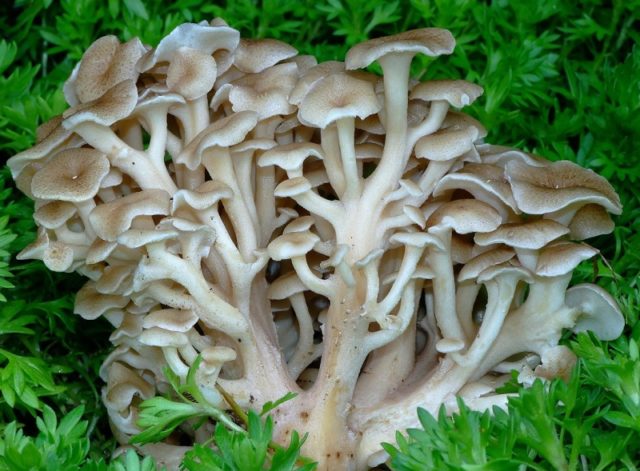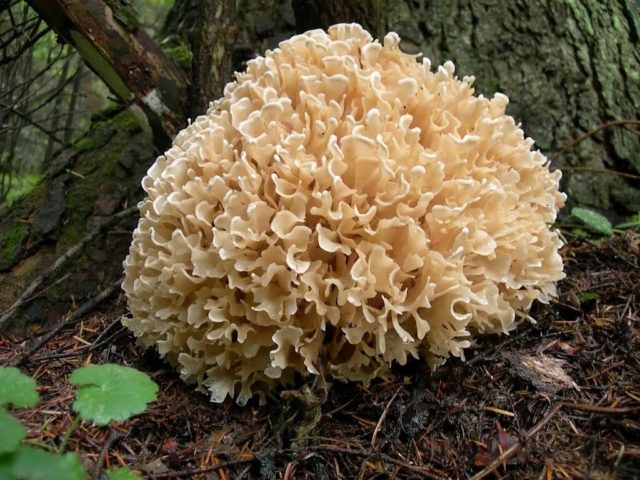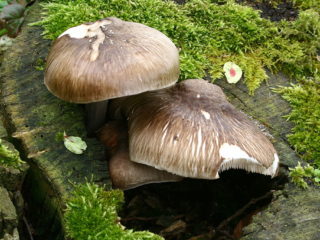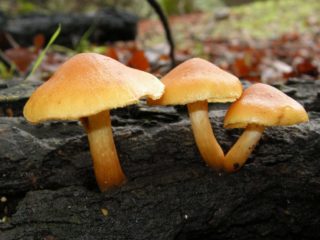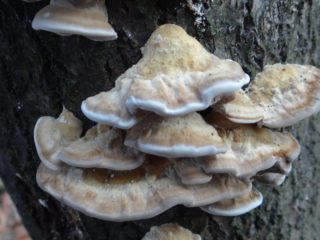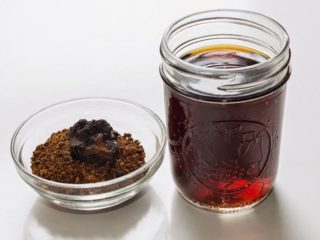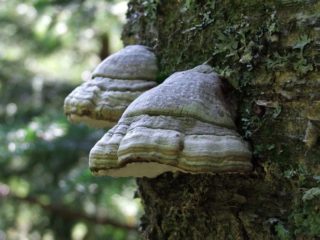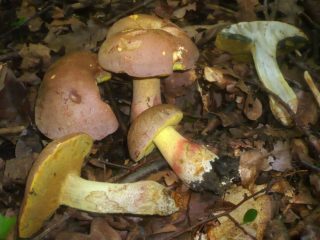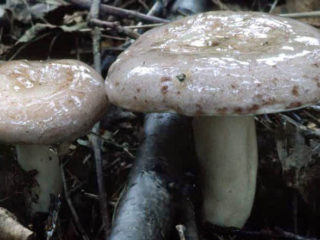Content
Ram mushroom is an unusual tree mushroom with a lot of valuable properties. You don't see it in the forest very often, but a rare find can be of great benefit.
Description of the meitake mushroom
The ram mushroom is also known by the names meitake, leafy polypore, curly grifola, leafy polypore and dancing mushroom. It is quite easy to recognize it when you meet it - the meitake fruiting body looks extremely original.
A video of the ram mushroom shows that this mushroom species looks like a peculiar bush, consisting of numerous small mushrooms with small caps.The legs of these mushrooms are long and well-defined, light in color, and the caps are similar to tree leaves or tongues; they are dark in color at the edges and lighter in the central part.
In general, the color of the unusual ram mushroom ranges from greenish-gray to gray-pink. The lower surface of the small caps is tubular, with small pores; the hymenophore descends onto the legs. If you break the meitake, the inside will be white and fragile, with a pleasant aroma of the pulp; many people detect a nutty tint in the smell.
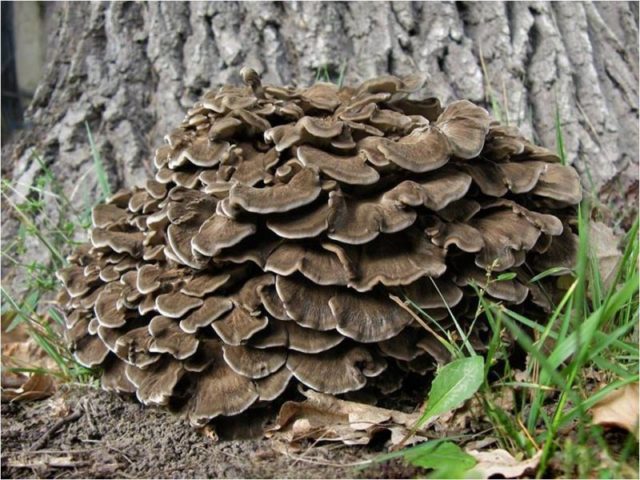
Grifola can grow very large and take up the entire basket when harvested.
Where does the ram mushroom grow?
The ram mushroom grows in Russia mainly in the Far East, the Volga region and the Urals. Meitake prefers broad-leaved forests, choosing mainly maples and oaks for its growth, and can also be found on beech and chestnut trunks. The ram mushroom is found in the Kaliningrad region, and all over the world you can also find it in North America, mainly in the eastern part, in Australia, in the temperate climates of Asia and Europe. Mass fruiting occurs at the end of August and lasts until mid-autumn.
The ram mushroom is considered quite rare; in Russia it is listed in the Red Book. Collecting it is most often prohibited, since the species is classified as endangered.
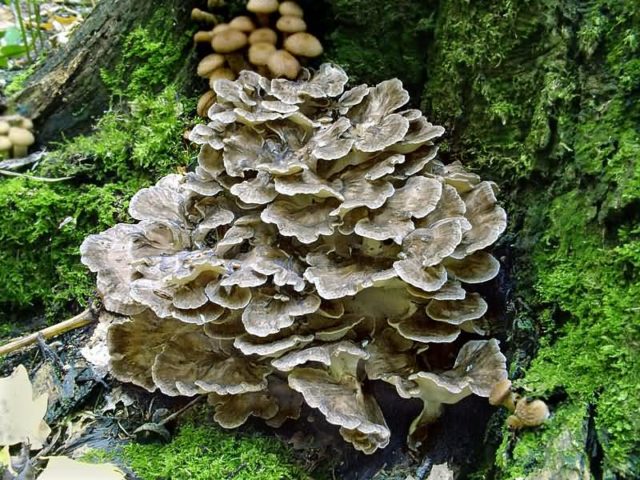
You can find curly grifola under the roots of oak trees
How does the ram mushroom grow
Curly griffola belongs to the arboreal category and grows mainly on stumps.Basically, the ram mushroom is located in the lower part of oaks and maples, sometimes it chooses the trunks of beeches, chestnuts and lindens; it can very rarely be found on pine trees. You can also see fruiting bodies on living trees, but this happens less often; usually the meitake settles on dead wood.
Despite its many valuable features, curly griffola, or mushroom ram, is a pest for trees. It causes white rot, so a tree affected by grifola quickly dies.
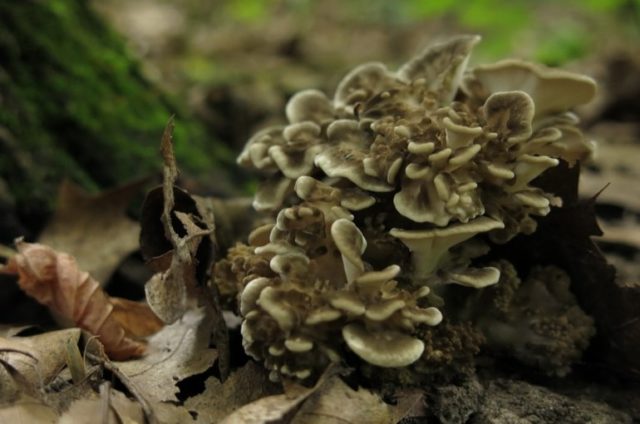
In one meytaka you can count about 200 small caps
What does a ram mushroom look like?
It is very easy to recognize a meitake - the grifola is characterized by a bushy structure, vaguely reminiscent of the wool of a ram. From the photo of the lamb's head mushroom, you can see that on average one grifola contains from 80 to 100 small mushrooms, sometimes the fruiting body is formed by 150-200 caps. Meitake is characterized by rapid growth; it can reach a weight of about 10 kg in just a few days.
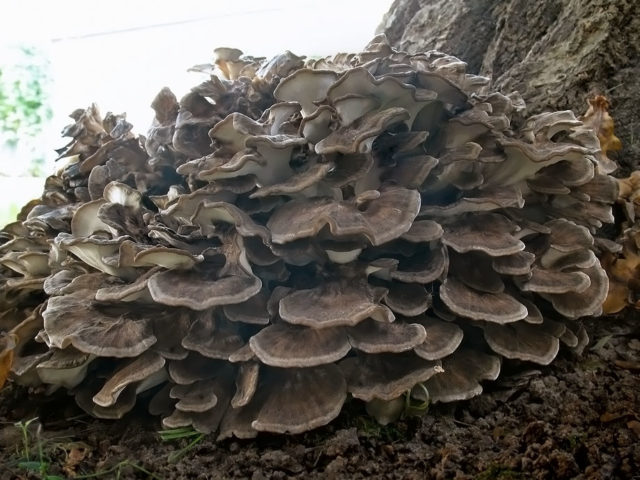
The weight of an individual fruiting body can exceed 10 kg
Varieties of ram mushroom
Under the name of the ram mushroom, in amateur sources and on forums you can find 2 more varieties of mushrooms. In fact, they belong to other mushroom families, but have a strong similarity to meitake, so they are often considered a species of ram mushroom.
Umbrella griffola
Related grifolas, umbrella and curly, are very similar in appearance, usually settle in the same places and bear fruit at the same time. Umbrella griffola is also suitable for eating and is even considered a delicacy.
The main difference is the shape of the fruiting body - the umbrella grifola has a fan-shaped cap, and the fruiting body has lateral legs.You can distinguish the mushroom by its pleasant dill smell.
Curly Sparassis
Another variety of ram mushroom is the so-called mushroom cabbage, or curly sparassis. The species has a certain similarity with grifola, since the body of sparassis also consists of dozens of small mushrooms. But at the same time, the color of curly sparassis is yellowish-beige, the cap petals are thin and delicate, and the shape of the fruiting body is spherical, which gives it a resemblance to a head of cabbage. In addition, sparassis grows mainly not in deciduous, but in coniferous forests under the roots of pine trees.
Curly sparassis mushroom belongs to the edible category; young fruiting bodies can be eaten.
Is curly griffa edible or not?
The tinder mushroom is considered edible and is highly valued for its unusual but pleasant nutty taste. Meitake is eaten boiled, fried, dried or pickled, served both as an independent dish and as a nutritious side dish. Dried mushroom powder is often used as a spicy seasoning.
The benefits and harms of ram mushroom
The specific nutty taste and aroma are not the only features of the curly griffola. The ram mushroom has numerous beneficial properties and can have a beneficial effect on human health.
The grifola pulp contains:
- subgroup B vitamins - from B1 to B9;
- vitamins E and D;
- magnesium and potassium;
- phosphorus, iron, zinc and copper;
- calcium and sodium;
- selenium;
- valuable amino acids - leucine, arginine, valine, tryptophan and many others;
- aspartic and glutamic acids;
- antibiotic compounds;
- phytoncides and saponins;
- flavonoids and triterpenes;
- steroids and polysaccharides.
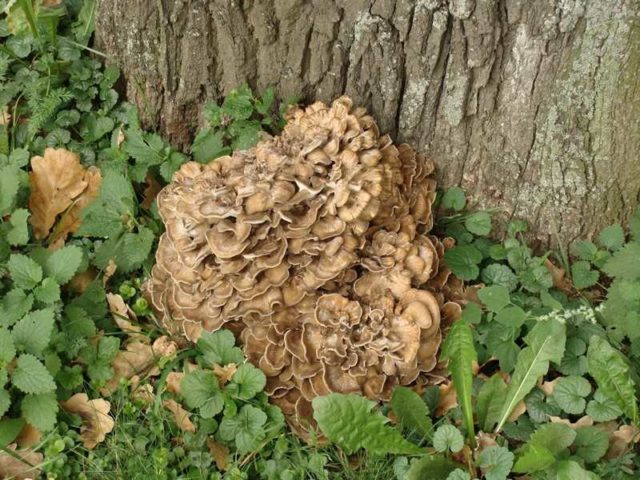
Grifola curly is not only tasty, but also very healthy
Thanks to this composition, curly griffola has a wide range of beneficial properties. When used it:
- cleanses the body and restores metabolic processes;
- strengthens blood vessels and reduces capillary fragility;
- disinfects and helps fight viruses and infections;
- thins the blood and has a positive effect on the quality of red blood cells;
- reduces the level of bad cholesterol and prevents the development of atherosclerosis;
- removes waste and toxins;
- strengthens the body's immune defense.
The beneficial properties and contraindications of meitake mushroom are always related to each other. When consuming the fruiting body, you need to remember that meitake can bring not only benefits, but also harm:
- Mushroom pulp contains a high amount of chitin. The substance is not digested in the body, and therefore, if you overeat, curly griffol can lead to constipation and abdominal pain.
- It is not recommended to use grifola for pregnant women and young children under 12 years of age. The product is considered too heavy for sensitive digestion.
- It is better to avoid ram mushroom if you have a sluggish stomach and a general tendency to constipation.
- You should not consume mushroom pulp if you have an individual intolerance to mushrooms - this can cause an allergic reaction.
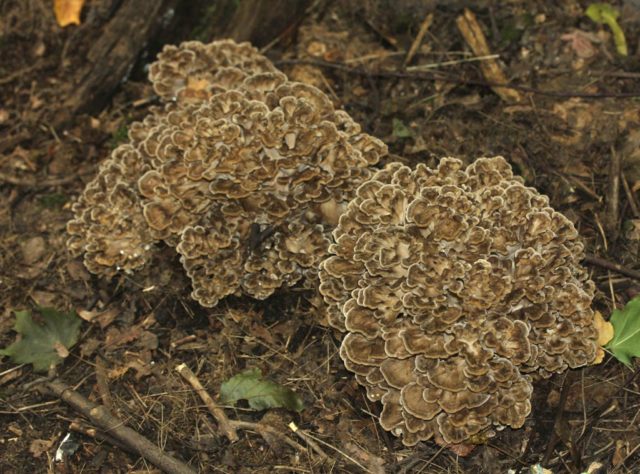
Medicines are prepared based on curly grifola
Also, curly griffola can cause harm if collected in an environmentally unfavorable area. Like any mushroom, meitake quickly absorbs harmful substances from the environment.It is better not to use fruit bodies that grow near busy roads or near industrial facilities as food; they will not bring any health benefits.
Medicinal properties of ram mushroom
Curly griffola with its varied and beneficial chemical composition is often used in folk medicine. In particular, the ram mushroom is used:
- to support heart and vascular health and strengthen the immune system;
- for the treatment of headaches and joint pain;
- for overwork and chronic fatigue;
- with anemia and deficiency of nutrients in the body;
- for removing toxins and as a natural anthelmintic;
- to regulate hormonal levels and maintain normal body weight;
- for the treatment of tuberculosis, bronchitis and other ailments of the respiratory system;
- for the treatment of digestive and stomach ailments;
- to normalize blood pressure.
It is especially worth noting the benefits of meitake mushroom for women; it improves well-being during menopause, and during painful periods it helps relieve cramps and discomfort. Since the mushroom pulp contains estrogen-like substances, curly griffola has a pronounced positive effect on the reproductive system and prevents the development of cancer of the uterus, ovaries and mammary glands. It is also useful for men to consume ram mushroom; it reduces the risk of developing prostate cancer.
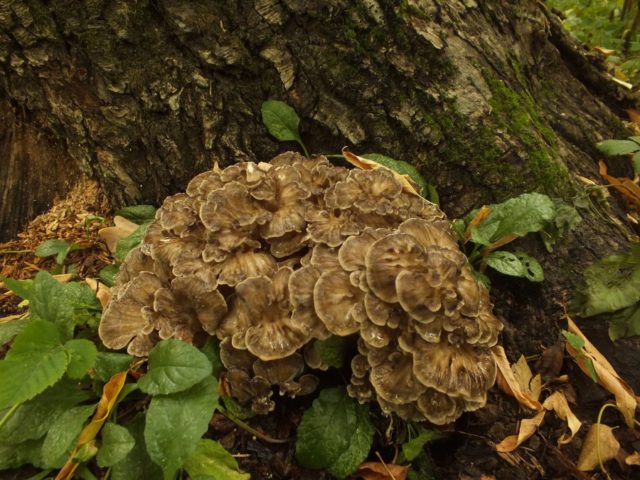
Meitake has proven anti-cancer properties
The use of meitake mushroom in folk medicine is practiced in several forms. Infusions, powders and extracts are prepared from fresh or dried pulp, which are beneficial for internal and external use.
Powder
Dried meitake is ground to a smooth powder and stored in paper bags or wooden containers. The powder can be used both internally and externally; it is first diluted with water. The product helps with inflammatory processes and promotes the healing of skin lesions.
Tincture
To prepare a healthy tincture, 3 large spoons of crushed dry grifola are poured into 500 ml of vodka and left for 2 weeks in a dark place. Use the finished product along with the sediment, without straining, and you need to drink the tincture 1 small spoon three times a day on an empty stomach.
The product helps improve immunity and promotes weight loss. The duration of the course of taking the tincture is no more than 3 months in a row.
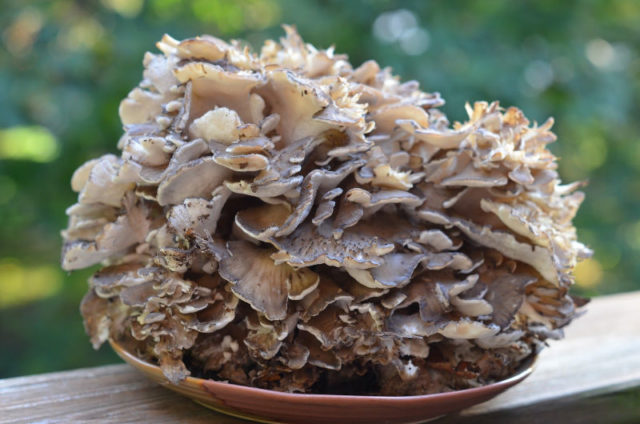
In folk medicine, grifola curly is infused and ground into powder.
Oil extract
Meitake-based oil is of great benefit for obesity, oncology and other ailments. About 3 large spoons of crushed dried meitake need to be poured with 500 ml of olive oil. The container is closed and put away to infuse in a dark place for 2 weeks, and then taken on an empty stomach, 2 small spoons.
Since the oil has a high fat content, it should be consumed no more than three times a day, and no more than 90 days in a row.
Water infusion
Grifola infusion with water is of great benefit for colds and inflammatory processes. A small spoon of crushed dry pulp is poured with 250 ml of water and left for 8 hours under the lid.
The infusion should be consumed three times a day without straining. Before use, shake the infusion so that useful sediment rises from the bottom. They usually drink homemade medicine for 3 months, but if you wish, you can use the meitake infusion for longer; it has no strict contraindications.
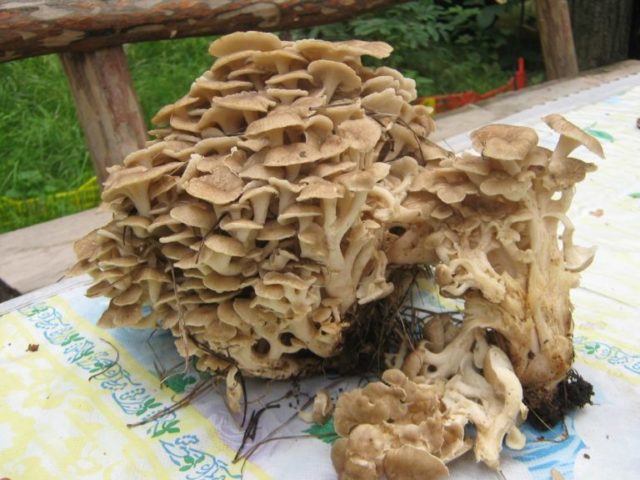
Meitake can be taken to treat a cold.
How to distinguish false mushrooms
In addition to curly sparassis and grifola umbellata, which many sources consider to be varieties of the ram mushroom, meitake has false counterparts. Some tree mushrooms resemble curly griffola in their structure and shape, but they do not have such good taste and benefits.
Meripilus gigantea
The most famous false twin of the meitake is considered to be the giant meripilus. It also grows at the roots of deciduous trees, choosing mainly oaks and beeches, and has a large fruiting body consisting of numerous fused caps. It is suitable for food consumption, but less tasty and healthy than meitake.
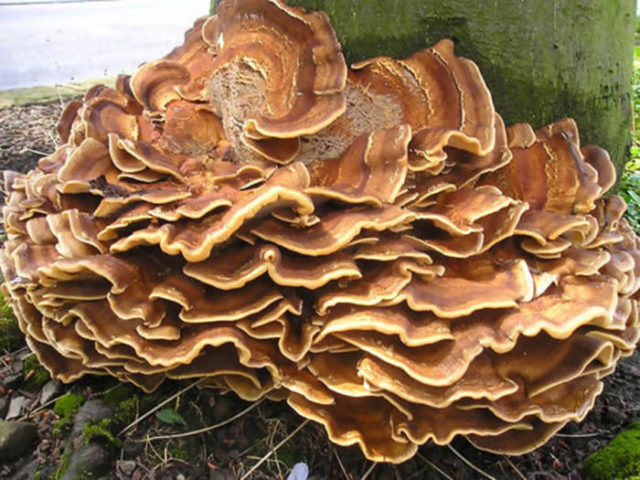
Meitake can be distinguished by the shape of its caps and the presence of long, thin legs.
Unlike the ram mushroom, meripilus does not have a pronounced stem - the caps that make up the fruiting body grow from a shapeless base. In addition, individual caps have a semicircular shape and are much larger in size than the caps of Grifola curly.
The main differences between the ram mushroom and its false counterparts are the long thin legs on which the individual caps rise, as well as the small size of the caps themselves. You can also recognize curly griffola by its characteristic nutty aroma.
Growing sheep mushrooms
The healthy and tasty griffola is a rare mushroom; for example, the ram mushroom is very rare in the Moscow region, and besides, in most regions it is listed in the Red Book. Therefore, growing it in your dacha is much easier and more practical than looking for it in the wild.
There are 2 ways to grow the red-listed ram mushroom at home - on a special substrate and on damp wood.
Growing curly griffola on a substrate
To grow a dancing maitake mushroom on your property, you will need to acquire a substrate consisting of hardwood sawdust and mycelium of this type; it can be ordered at a specialized store. The growing algorithm looks like this:
- the substrate is doused with boiling water to destroy possible harmful microorganisms, and wait until it cools down a little;
- after this, the acquired mycelium is mixed with sawdust and the mixture is placed in small plastic bags;
- the bags are tightly tied and several holes are made in them for air access;
- the substrate and mycelium are placed in a closed room with a temperature of about 25 ° C, moderate lighting and good ventilation.
The first shoots, subject to the conditions for growing the ram mushroom, will appear within 3-4 weeks. Every few days the substrate will need to be moistened to prevent it from drying out. It will be possible to harvest the curly griffola harvest in 3-4 months, and in total the mushroom mycelium can bear fruit for up to 6 years in a row.
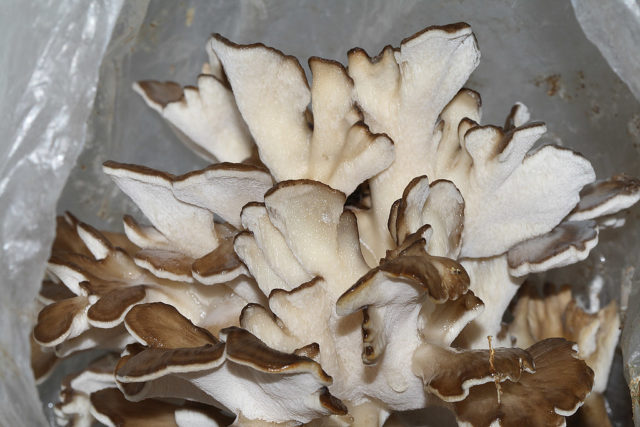
Meitake can be grown at home in a plastic bag
Growing on a leafy log
The second method of growing meitake involves using wood, this allows you to create the most natural conditions for the mushroom mycelium. You need to act according to the following algorithm:
- a small deciduous log, clean and not rotten, is soaked for a couple of days;
- then for another 2 days the wood is dried in the fresh air and holes about 5-7 cm deep and up to 1 cm in diameter are made in the log;
- carefully place the purchased mycelium into the prepared holes and cover it on top with a ball rolled from sawdust;
- the log is covered with a plastic bag to create greenhouse conditions and placed in a barn or basement with constant lighting and a temperature of about 20-25 ° C.
From time to time the log needs to be watered to prevent the wood from drying out. In about 3 months, the curly griffola will be able to produce its first harvest.
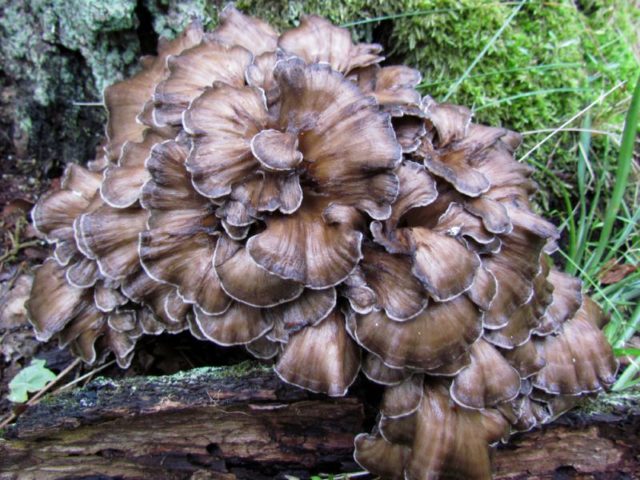
In the countryside, maitake is often grown directly on a log.
Conclusion
The ram mushroom, or curly griffola, is a rare delicious mushroom listed in the Red Book. It is difficult to find it in nature, but curly griffola can be grown in your own garden and used for both culinary and medicinal purposes.
